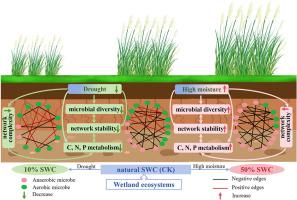Bacterial network complexity drives carbon, nitrogen and phosphorus metabolism potential under short-term soil water content changes in wetlands
IF 7.7
2区 环境科学与生态学
Q1 ENVIRONMENTAL SCIENCES
引用次数: 0
Abstract
Wetland soil microbial communities play pivotal roles in biogeochemical cycling; however, how their network complexity mediates carbon (C), nitrogen (N), and phosphorus (P) metabolism in response to soil water content (SWC) changes remains unclear. In this study, soil samples from the Zhalong, Momoge and Xianghai wetlands in Songnen Plain of China were incubated under natural (CK), drought (10 % SWC), and high SWC (50 % SWC) conditions, followed by metagenomic sequencing to evaluate the impact of SWC changes on bacterial community structure and function. The results showed that soil bacterial diversity and network complexity decreased under drought but recovered under high SWC, with Proteobacteria and Actinobacteria displaying divergent responses. C fixation pathways (rTCA and DC-HB cycles) were significantly enriched under 50 % SWC, which correlated strongly with enhanced bacterial interactions. The abundance of denitrification genes (norBC, nosZ) decreased under drought but increased under high SWC. P metabolism (purine metabolism and two-component systems) showed strong SWC dependence, with key genes (PstS, phnDC) increased in abundance under 50 % SWC. Notably, bacterial network complexity tightly coupled with metabolic pathways, indicating SWC driven community restructuring regulates wetland soil C, N and P cycling. These findings underscore the critical importance of hydrological management in maintaining bacterial-mediated nutrient cycling functions of wetland ecosystem under climate change.

湿地短期土壤含水量变化下细菌网络复杂性驱动碳、氮、磷代谢潜力。
湿地土壤微生物群落在生物地球化学循环中起关键作用;然而,它们的网络复杂性如何调节碳(C)、氮(N)和磷(P)代谢,以响应土壤含水量(SWC)的变化,目前尚不清楚。本研究采用自然(CK)、干旱(10% SWC)和高SWC (50% SWC)条件下,对松嫩平原扎龙、莫莫格和香海湿地土壤样品进行了培养,并进行了宏基因组测序,以评估SWC变化对细菌群落结构和功能的影响。结果表明,土壤细菌多样性和网络复杂性在干旱条件下下降,但在高SWC条件下恢复,变形杆菌和放线菌表现出不同的响应。在50% SWC条件下,C固定途径(rTCA和DC-HB循环)显著富集,这与细菌相互作用增强密切相关。反硝化基因(norBC, nosZ)丰度在干旱条件下降低,而在高SWC条件下增加。P代谢(嘌呤代谢和双组分系统)表现出强烈的SWC依赖性,关键基因(PstS, phnDC)在50% SWC下丰度增加。值得注意的是,细菌网络复杂性与代谢途径紧密耦合,表明SWC驱动的群落重构调节了湿地土壤C、N和P的循环。这些发现强调了水文管理在气候变化下维持细菌介导的湿地生态系统养分循环功能的重要性。
本文章由计算机程序翻译,如有差异,请以英文原文为准。
求助全文
约1分钟内获得全文
求助全文
来源期刊

Environmental Research
环境科学-公共卫生、环境卫生与职业卫生
CiteScore
12.60
自引率
8.40%
发文量
2480
审稿时长
4.7 months
期刊介绍:
The Environmental Research journal presents a broad range of interdisciplinary research, focused on addressing worldwide environmental concerns and featuring innovative findings. Our publication strives to explore relevant anthropogenic issues across various environmental sectors, showcasing practical applications in real-life settings.
 求助内容:
求助内容: 应助结果提醒方式:
应助结果提醒方式:


